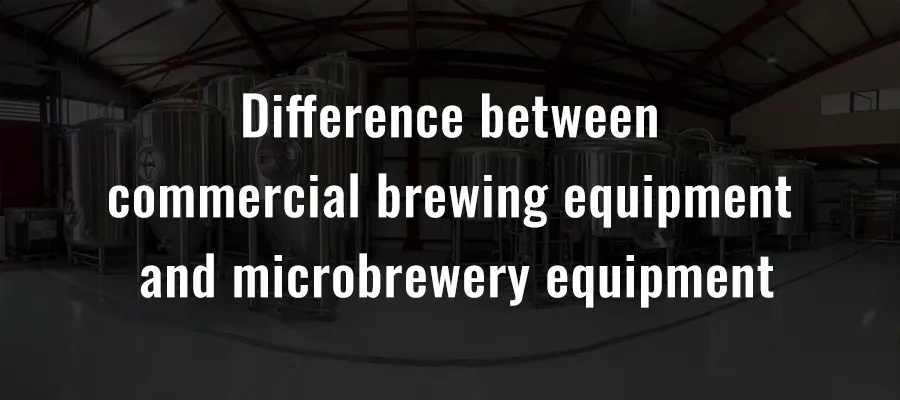As a business brewer or an aspiring product vendor, there are details you must know when opting for either more significant equipment or a smaller one. There are differences to note before to venture into the business:
1. Synthetic Substances
This one means all-day-round business. Commercial brewers massively use grounded synthetic compounds to clean and purify more than a microbrewery. This is contrary to a microbrewery, which typically doesn’t use these levels of the substance.
Purifying and cleaning is a vital factor in the brewery business; besides its one of the hectic tasks that can be done. For this case, commercial brewers utilize a CIP; a clean set up framework for a more substantial part of vessel cleaning. Besides, this framework is designed as a shower ball inside the vessel and close to the roof; enabling synthetics to clean out the dividers of the tank. In the process of cleaning, the synthetic removes all types of dirt that have been there for some time.
Moreover, synthetics that comprise burned soft drinks, nitric, and phosphoric acids do excellent work; however, they require high temperatures of up to 160oF for complete viability. On the other hand, sterilization uses peracetic acid, which is hazardous to be around at any capacity, more so when it’s not destabilized.
Microbrewery, on the other hand, also experience unwanted substances that may occur due to all-time operations. They also require to be cleaned. However, microbrewery uses small scale machinery in cleaning.
2. Technicalities
A commercial brewing machine is designed more technically compared to a microbrewery for its purposes. Typically, a lot of constraints is involved. The reason why this equipment is designed as such is because of its commercial purposes; there is a need to produce larger quantities to satisfy the market; it’s basically special equipment. Additionally, unlike microbrewery, industrial equipment is computerized, and the transitioning process may likely face glitches, affecting efficiency.
On the other hand, microbrewery allows you to adjust your ingredients. For instance extraction of grains is up to 80% for a microbrewery and 90% for commercial, and this brings the difference in taste between the final products; sugar content is higher in the latter.
3. Cost
While microbrewery and commercial brewing equipment vary in size, a number of processes, and operations among others, so is the initial cost of purchase. A commercial brewer is comprised of distinct parts designed for specific brewing stage purposes. Contrarily, a normal microbrewer consists of a single room where the whole brewing procedure is done. However, much of the brewing process remains unchanged since the process typically involves quite guileless biochemical processes.
The cost of these equipment varies depending on the material, status of the equipment (new or second hand) and size. With all these factors considered, it’s clear that a commercial brewery costs more than microbrewery equipment.
What is more, the repair cost for commercial equipment is slightly higher compared to others.
4. Consistency
Brewing lager involves technicality and excellent science knowledge; all these can be left for homebrews. Although when reliability is crucial, something must be done. Microbrewery equipment is simply a set of few tanks, dry-jump yeast, and other substances.
However, in a commercial company, experiments done on microbrewery are reserved only for firkins and barrel-maturing; hence outdoing the micro one.
The contrary is that microbrewers will solely be on small outputs of the product, which tend to be thicker. Additionally, the brew may at some point require fixings, and this can be time-consuming.
5. Size Matters
Another difference between commercial and microbrewery equipment is the size. The difference is evident on the amount of beer produced by the commercial breweries; the equipment has the ability to create a higher capacity compared to a microbrewery. Additionally, a typical microbrewer produces at least 5 gallons on each batch, unlike commercial which produces approximately 1000 gallons.
6. Efficiencies
Commercial brewery requires a broader framework for the sake of consistent production, unlike microbrewery. Moreover, with a more extensive brewery apparatus, the output is enhanced. Therefore substances like sugar and IBUS, among others are added in the process, and this can be cost-effective to consumers.
Contrarily, microbreweries use more grains and take longer to breakdown, hence prolonged time to gain the byproduct. Therefore, smaller equipment is time-consuming compared to commercial brewer, which also is substantial in size.
7. Temperatures
Vessels incorporated in brewing equipment are typically for steam or glycol purposes where, in this case, the latter can be termed as “liquid catalyst.” This catalyst is used on the “cool” end of the bottling tasks to control the temperature of the fermenters; they typically monitor the heat formed during maturation.
Similarly, microbreweries use an apparatus to release a similar amount of heat required for brewed beers. However, it doesn’t vast processes like of commercial equipment.
In conclusion, if you want to venture into business, commercial brewing equipment is essential and profitable compared to microbrewery equipment. This is because industrial equipment has excellent storage and can hold a capacity of up to 500 gallons a single day. Additionally, compared to a microbrewery, it has more complex and improved features; leading to a more straightforward beer making process. Similarly, with the efficiency, profit margins remain high.
Logically, both can be used for business, but at least for a start, one can start with micro equipment, which is cheaper than commercial brewing instrument. However, this will depend on the type of business and the capital you have.




